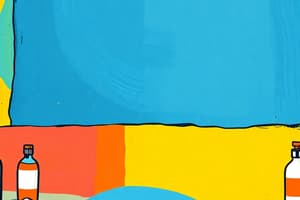Podcast
Questions and Answers
What is a market?
What is a market?
A set of individuals and organisations who buy or want to buy products or services.
Who is a buyer?
Who is a buyer?
Anyone who may buy a given product, having a latent interest in the product and the means to acquire it.
What are the 4 generic market types?
What are the 4 generic market types?
Consumer, Producer, Reseller, and Government markets.
What are the 6 O's of marketing?
What are the 6 O's of marketing?
Who are the occupants in a consumer market?
Who are the occupants in a consumer market?
What are the objects bought in a market?
What are the objects bought in a market?
Why is it important to consider the 6 O's of marketing?
Why is it important to consider the 6 O's of marketing?
What are the 5 different roles a person can play in a buying decision?
What are the 5 different roles a person can play in a buying decision?
What are the characteristics that consumers vary according to?
What are the characteristics that consumers vary according to?
What type of family structure is characterized by joint decision-making?
What type of family structure is characterized by joint decision-making?
What are the four types of needs that a consumer tries to satisfy when buying a product or service?
What are the four types of needs that a consumer tries to satisfy when buying a product or service?
What are the four major factors that influence consumer buying behavior?
What are the four major factors that influence consumer buying behavior?
What is the term for a family structure where the husband dominates the decision-making process?
What is the term for a family structure where the husband dominates the decision-making process?
What is the term for a family structure where decisions are made jointly, with an equal number of separate decisions taken by each partner?
What is the term for a family structure where decisions are made jointly, with an equal number of separate decisions taken by each partner?
What is the most fundamental determinant of a person's wants, needs, and behavior?
What is the most fundamental determinant of a person's wants, needs, and behavior?
What is the term for a group of people that influences an individual's attitude, opinions, and values?
What is the term for a group of people that influences an individual's attitude, opinions, and values?
What is the largest and most enduring role that influences an individual's attitudes, opinions, and values?
What is the largest and most enduring role that influences an individual's attitudes, opinions, and values?
What is the term for the social standing that influences where purchases are made?
What is the term for the social standing that influences where purchases are made?
What changes in an individual's preferences and purchasing habits as they get older?
What changes in an individual's preferences and purchasing habits as they get older?
What are the 7 stages in a family life cycle?
What are the 7 stages in a family life cycle?
What are the two main categories of products based on durability?
What are the two main categories of products based on durability?
What are the three groups of products based on consumer shopping habits?
What are the three groups of products based on consumer shopping habits?
What are the key factors considered when buying shopping goods?
What are the key factors considered when buying shopping goods?
What are speciality goods characterized by?
What are speciality goods characterized by?
What are the factors that influence the frequency of purchase?
What are the factors that influence the frequency of purchase?
What are the six elements of the marketing mix?
What are the six elements of the marketing mix?
What is an example of a service-based product category?
What is an example of a service-based product category?
Who participates in consumer buying decisions in an organisational context?
Who participates in consumer buying decisions in an organisational context?
Study Notes
Product Categories
- Non-durable goods: frequently purchased, low effort, e.g., bread, veggies
- Durable goods: infrequently purchased, high effort, e.g., clothes, cars
- Services: e.g., screening services in a pharmacy
Consumer Shopping Habits
- Convenience goods: frequently purchased, minimum effort
- Shopping goods: selection, comparison, then purchase, e.g., clothing, furniture
- Speciality goods: unique characteristics, significant purchasing effort, e.g., photographic, computer components
Market Buying Occasions
- Frequency of purchase influenced by:
- Rate of consumption of product
- Seasonal factors
- Day or week
- Economic conditions
Organisation Buying Decision
- Participants in consumer buying decision:
- Initiator: suggests/thinks of buying product
- Influencer: carries purchasing idea further
- Decider: ultimately determines buying
- Buyer: makes actual purchase
- User: uses product/service
The Six O's of Marketing
- Occupants: individuals who acquire goods or services
- Objects: what the market buys
- Occasions: when the market buys
- Organisation: who participates in buying decision
- Objectives: why the market buys
- Operations: how the market buys
Market Types
- 4 generic market types:
- Consumer market
- Producer market
- Reseller market
- Government market
Buyer Characteristics
- Cultural: culture influences wants, needs, and behavior
- Social:
- Reference groups: groups influencing attitude, opinions, and values
- Social class: influences purchase decisions
- Family: influences attitudes, opinions, and values
- Personal:
- Age and life cycle: influences what we like and buy
- Roles and statuses: influence behavior and buying behavior
Studying That Suits You
Use AI to generate personalized quizzes and flashcards to suit your learning preferences.
Description
Learn about different types of product categories, including non-durable goods, durable goods, and services, and understand how consumer shopping habits influence product classification.




